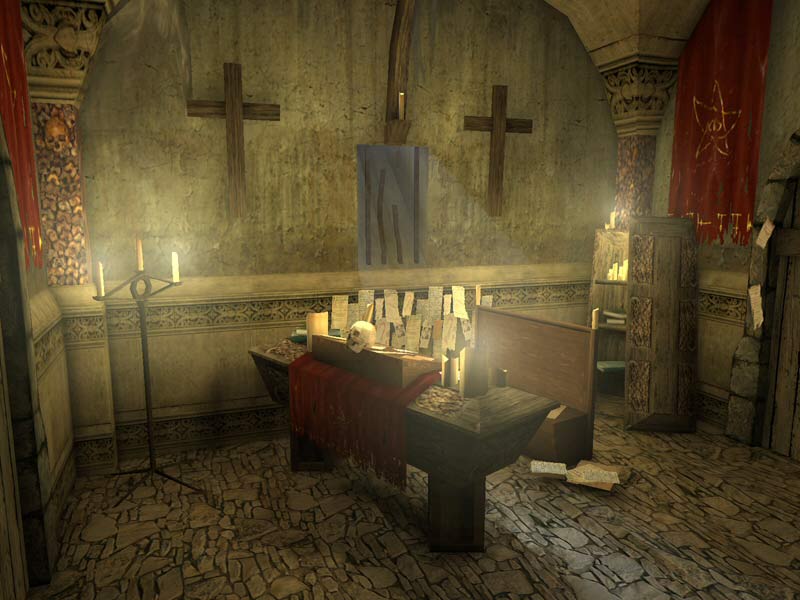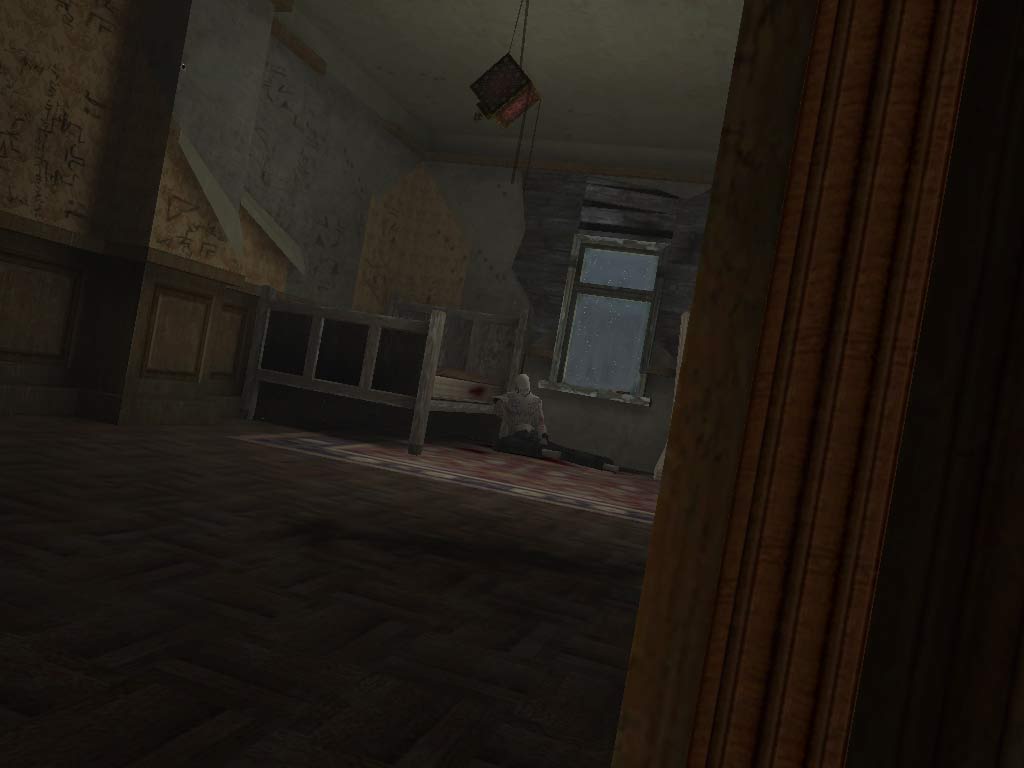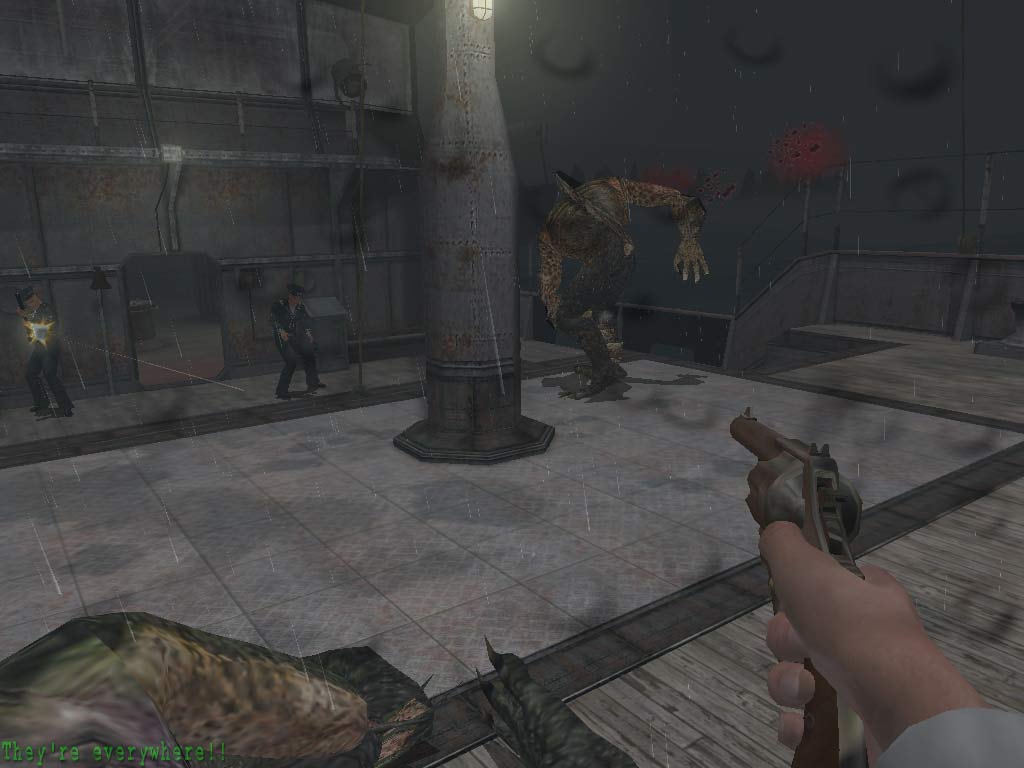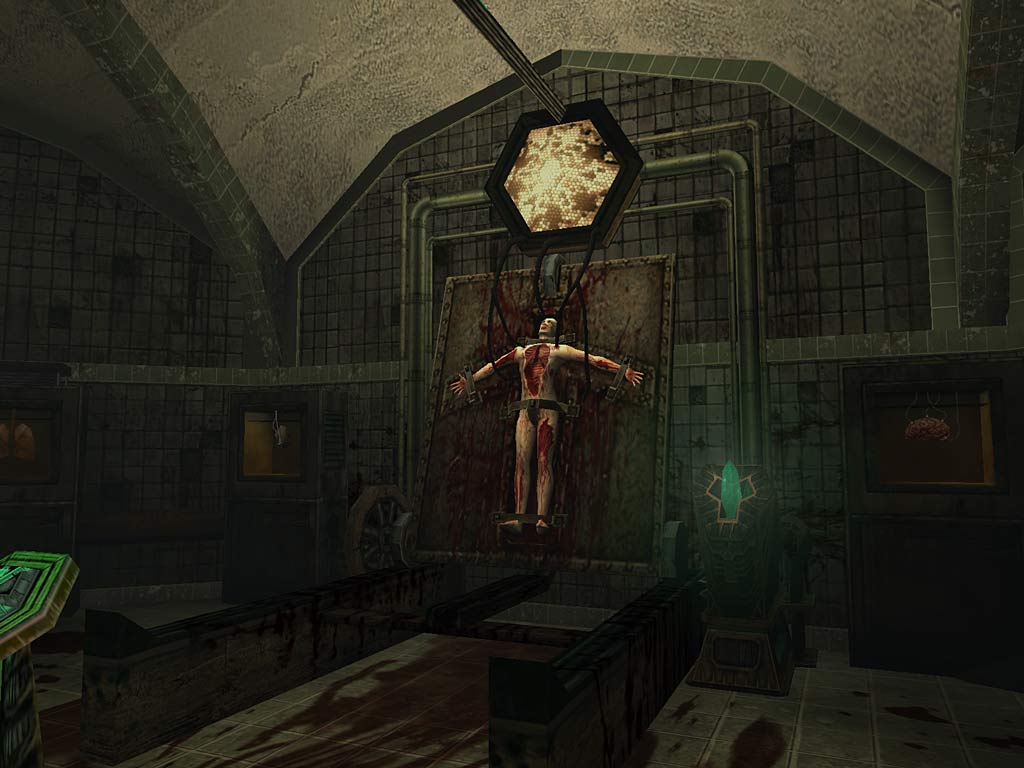
Two key elements in fostering the atmosphere of Dark Corners were the HUD-less display and sanity meter. "The lack of a HUD came from the importance of immersing the player and making sure there were fewer distractions reminding you it was a videogame," Chris recalls. "This fed naturally into the sanity system; anything we planned on doing visually just felt like it was never going to be as effective if you had a bunch of elements on the screen."
Dark Corners' sanity worked in the background, quietly logging instances of terror against periods of reassuring calm. "It was a resource, just like any other health resource," tells Gareth. “There were field-of-vision influences, so if you looked directly at a corpse it would degrade your sanity more effectively than if it was in your periphery."
Should the player let Jack Walters encounter too many horrors, the screen would blur, Jack would see visions and mumble to himself. Persist in the behaviour and the character would take his own life, either by gun, or strangulation—a somewhat intense occurrence. "You were supposed to be able to manage the sanity," explains Gareth, "as we wanted players to experience it, but not so much that it ends the game."
With the switch of publisher, the Xbox became the primary platform with PC and PlayStation 2 versions to follow, the former lead version relegated to console-port status, as Bethesda also pressed Headfirst for a PlayStation 2 version. "We said, 'No chance,'" grimaces Gareth, "so they outsourced it. I recall an awkward conversation when the other developer phoned up and asked us questions on its feasibility. They’d tried everything, but it was clear it would never happen. It had half the memory again of the Xbox, so the tech was just hopelessly compromised." With the change from PC to Xbox, the game had already undergone many sacrifices, notably the removal of Jack’s arms and optimisation of the game’s ambitious levels.
Simon The Sorcerer 3D
System: PC
Year: 2002
Deadlands
System: PC
Year: Unreleased
Call of Cthulhu: Destiny’s End
System: PC, PlayStation 2, Xbox
Year: Unreleased
Dark Corners Of The Earth was finally released in 2005. Bethesda, delighted by the runaway success of the third Elder Scrolls chapter, Morrowind, had Oblivion on the way. "We proudly went to the nearest major videogame store the week of release,” recalls Chris painfully, “and they didn’t have any copies. They hadn’t even heard of it. That hurt given how much personal time we’d sacrificed."
Had Dark Corners become a runaway success, it was too late for Headfirst, which was affected by the elongated development. "The PC version very nearly didn’t happen," says Gareth, "as I was practically the only person left in the building, and hadn’t been paid for months. But we couldn’t stand it not coming out after years of work."
Ultimately, despite poor sales, and mixed reviews, Dark Corners remains a game its team are very proud of 12 years later. "The production values and polish may not have been great," says Chris, "but it was a labour of love for us, and there were a lot of original ideas on display—maybe too many. In a medium where journalists are screaming out for originality, it would have been nice to receive a bit more credit for trying something different."
The biggest gaming news, reviews and hardware deals
Keep up to date with the most important stories and the best deals, as picked by the PC Gamer team.
Gareth, who left for Midlands developer Eurocom after Headfirst collapsed, says, "It's without shadow of a doubt my favourite game I've worked on, because of the way the team gelled together and the original nature of it. No other game has had its longevity; every year I see it in lists of 'top ten games no one ever played' or ‘great games for Halloween'. It’s a bit of a curiosity, and in some respects I prefer that it was a commercial failure, yet a cult success, because it shaped my enthusiasm for the industry."
Bored of relentless shooting and so-called vulnerable heroes, tooled up to the max with automatic rifles and shotguns? Why not jump into the fragile skin of investigator Jack Walters and attempt to uncover the horrible secret of the town of Innsmouth. Just beware of your own mind, dear reader, should it recoil in terror at glimpsing those insidious, pervading, dark corners of the earth.
How the developers made Hotel Hell

We talk to designer Ed Kay and the others involved with Dark Corners’ infamous escape scene.
Ed Kay: I can’t take all the credit for the idea, but when I came on board it had already gone through several iterations. I was given a partially broken, messily coded, fairly unfun level and had to get it finished, quickly. We could only have six enemies active at once and they are teleported around. We faked other stuff , too, unowned yelling voices, gunshots with no shooter, and so on. The whole level is smoke and mirrors. I think the build up to it is amazing, since it’s previously about the atmosphere and the player isn’t under any real threat. Then suddenly, you’re awake in the middle of the night and it goes from ‘take your time and explore’ to ‘run for your sodding life’!
Gareth Clarke: We wanted to terrify people and give them the sense that this wasn’t like other games—to feel the pressure. Thing is, if you turn off the sound, it’s not actually that hard. The voices, and music, got players stressed and panicky. It has an element of Simon Says about it but I really loved it, and the pressure it put you under. It was very clever.
Chris Gray: We knew that was going to be challenging to put together, especially as running away is such an unusual concept for players. Of all the sequences in the game it probably went through the most hands, and in all honesty, we were never entirely happy with it. However, I think it’s a highly original chapter, and if you can forgive the frustrations, it’s a wonderfully terrifying experience to play.
Ed Kay: Honestly, looking back, it was way too hard! With a little more experience and time, we’d have playtested it more and pulled the difficulty a bit.
Defining moments

Attack of the Fishmen
Unarmed and alone, Jack is cornered in his dingy Innsmouth hotel room by a gang of tainted locals. Dark Corners' infamously frustrating scene is unlikely to be one you're going to complete first time, requiring practice and timing to elude the fishmen. But it's an exhilarating and intense experience nonetheless.
Dagon attacks
Aboard the ship Urania, Jack and the crew must fend off a clutch of deep ones as they approach, Devil's Reef. Pounding the deck, their boss Dagon surfaces and Jack must avoid his attacks in between letting off shots from the ship's deck cannon. Clever effects give the impression of the boat moving, despite it not actually going anywhere throughout the level.
The death of Ramona Waite
Having been pointed in the direction of Thomas Waite in order to solve the mystery of Brian Burnham's disappearance, the hero accidentally releases a horrible creature resident in the attic of the Waite household—Mrs Waite herself, who proceeds to slaughter her own daughter as she escapes into the streets. Thomas Waite himself later commits suicide with the guilt—nice going, Jack.

The Prisoner of Yith
Dark Corners wastes little time in establishing its horrors. In the basement of the dilapidated manor house of the game's intro, there’s a truly sickening and bizarre sight. A poor victim, pinned to the wall, is being kept alive despite having all his major organs removed and stored in tanks around the room. This, and subsequent events of the intro conspire to put Jack into Arkham Asylum for several years.
An unspeakable horror
Having saved J Edgar, Jack encounters the first of several large Cthulhu creatures in the bug-eyed, slimy Shoggoth. It cannot be harmed directly and besides, staring at the monstrosity for too long will destroy Jack's sanity. Only by manipulating the valves and pipes around it can the Shoggoth be destroyed, but escape is temporary—its liquefied remains chase the investigator through the refinery’s corridors. Eek.
Too much fear will kill you
Like much of Dark Corners' interactivity, there’s no onscreen bar or statistic to help the player keep track of Jack's sanity. Visual cues, visions and his incoherent babbling are the clues you have, and ignore them at your peril. Eventually, overcome by his fears, Jack will take his own life by shooting himself or, as in this picture, strangling the life from his body with his own bare hands. Crikey.
The collective PC Gamer editorial team worked together to write this article. PC Gamer is the global authority on PC games—starting in 1993 with the magazine, and then in 2010 with this website you're currently reading. We have writers across the US, UK and Australia, who you can read about here.


